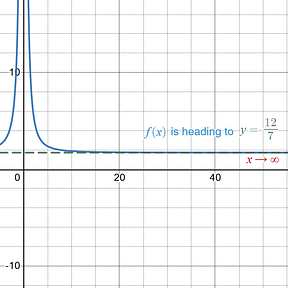Example 3: Leading Behavior (Balanced)
|
|
|
|
Step 1: Determine if you are being asked to find a single limit, or , or if you are being asked to find the horizontal asymptotes of an equation, which means you have to do both limits no matter what.
Here we are only being asked to find the single limit as x approaches infinity, . |
|
|
Step 2: Determine the leading behavior (dominant term) on the top and bottom of your fraction.
In this example is the dominant termon the top and the bottom of the fraction because it is the highest power of x. The 12 and 7 come along for the ride because they are the coefficients of the dominant terms. |
|
|
Step 3: Determine which of the three possible behavior scenarios you are working with.
Since this dominant term is on the top and bottom of the fraction you would call this a Balanced situation. |
|
|
Step 4: Draw your final conclusion about your limits based upon the Step 3 scenario, and give your final answer.
Since we have a Balanced scenario, the on the top and bottom will essentially cancel each other out and we are left with their coefficients as our solution.
|
|
|
Final Result:
Meaning: The limit as approaches of is .
There is a horizontal asymptote as approaches , and it is . Remember you only know what is happening in that single direction, and cannot say anything about the other direction,.
|
|

